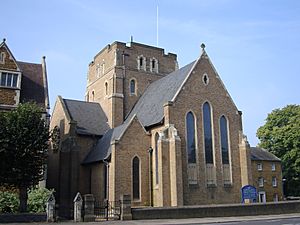Northampton Cathedral facts for kids
Quick facts for kids Northampton Cathedral |
|
|---|---|
| Cathedral Church of Our Lady Immaculate and St Thomas of Canterbury, Northampton | |

The east end of the cathedral, built 1948-55
|
|
| Lua error in Module:Location_map at line 420: attempt to index field 'wikibase' (a nil value). | |
| OS grid reference | SP7529061672 |
| Location | Northampton, Northamptonshire |
| Country | England |
| Denomination | Roman Catholic |
| Website | www.northamptoncathedral.org |
| History | |
| Former name(s) | Chapel of St Felix |
| Status | Active |
| Dedication | Our Lady Immaculate and St Thomas of Canterbury |
| Consecrated | 1864 |
| Architecture | |
| Functional status | Cathedral |
| Heritage designation | Grade II |
| Designated | 22 January 1976 |
| Architect(s) | Augustus Welby Northmore Pugin |
| Architectural type | Gothic Revival |
| Groundbreaking | 1840 |
| Administration | |
| Diocese | Northampton |
| Province | Westminster |
The Northampton Cathedral is a special Roman Catholic church in Northampton, England. It's also known as the Cathedral Church of Our Lady Immaculate and St Thomas of Canterbury. This cathedral is the main church for the Bishop of Northampton. It serves as the "mother church" for the Diocese of Northampton. This area includes Northamptonshire, Bedfordshire, Buckinghamshire, and part of Berkshire. You can find the cathedral in the northern part of Northampton, on Barrack Road.
Contents
History of the Cathedral
How the Church Started
In 1823, a church leader named Bishop John Milner sent a priest, Father William Foley, to Northampton. His job was to create a lasting Catholic presence in the town. Father Foley first used a small house as a chapel. Then, he bought land where an old church, St Andrew's Priory, Northampton, once stood. This was a historic spot where Thomas Becket had once gone into exile. Father Foley decided to build a new chapel there. This chapel, named after Saint Andrew, opened on October 25, 1825.
Building the Cathedral
The story of the current cathedral building began in 1840. The first Bishop of Northampton, William Wareing, asked a famous architect, Augustus Welby Northmore Pugin, to design a new chapel. The old St Andrew's chapel was too small for the growing number of people. The new chapel was finished in 1844.
Soon, even this new building became too small. Bishop Wareing's successor, Francis Amherst, chose Pugin's son, Edward Welby Pugin, to design a larger part. This new section, called the nave, was added to make the building a cathedral. It opened in 1864 and was dedicated to Our Lady Immaculate and St Thomas of Canterbury. The beautiful stained glass windows were made in the 1860s by John Hardman of Birmingham. They show bright colors and pictures of saints like St Peter, St Edward the Confessor, and St Thomas Becket.
Expanding the Cathedral
The cathedral stayed this way until 1948. At that time, Bishop Leo Parker decided to make the west end of the cathedral bigger. To do this, part of the original St Andrew's chapel had to be taken down. The part of the chapel that remained, including its first altar, is now in the sacristy and chapter room of the cathedral.
The building work was finished seven years later, in 1955. Albert Herbert was the architect who led this project. He oversaw the replacement of the old west end with a straight one. He also added transepts (the arms of the cross shape) and a tower where the parts of the church meet. Bishop Leo Parker passed away in 1975 and was buried in the Blessed Sacrament Chapel.
Changes Inside the Church
In 1998, the sanctuary, which is the main altar area, was updated. A new window, designed by Joseph Nuttgens, was placed in the Blessed Sacrament Chapel. Joseph Nuttgens was a student of Karl Parsons and has artwork in Windsor Castle. The original choir stalls were moved from the main altar to the chapter room. The cathedra, which is the bishop's special throne, was replaced. The new one was carved by Stephen Foster and designed to go with the artwork of the Holy Spirit behind it.
Music at the Cathedral
The cathedral has two organs for music. One is an older pipe organ that works with a special mechanical system. It was built in 1976 by Hendrik ten Bruggencate. The other is a modern digital organ. This digital organ was installed in May 2008. Its control panel is in the west gallery of the church.
The cathedral also has a regular choir. This choir sings during the 11:00 AM Sunday Mass. They also perform at other important church services.
The Cathedral as a Parish Church
The Northampton Cathedral also works as a local parish church. This means it serves the people living nearby. It hosts different volunteer groups from the parish. For example, the local Society of Saint Vincent de Paul meets there. This group helps organize ways to serve people in need in the local area.
See also
 In Spanish: Catedral de Nuestra Señora y Santo Tomás (Northampton) para niños
In Spanish: Catedral de Nuestra Señora y Santo Tomás (Northampton) para niños
- Diocese of Northampton
- Northampton
- List of churches in Northampton
Images for kids


